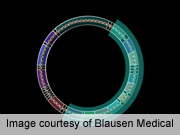- Navigating Your Midlife Crisis: Embracing New Possibilities
- City Raccoons Showing Signs of Domestication
- Mapping the Exposome: Science Broadens Focus to Environmental Disease Triggers
- One Week Less on Social Media Linked to Better Mental Health
- Your Brain Changes in Stages as You Age, Study Finds
- Some Suicide Victims Show No Typical Warning Signs, Study Finds
- ByHeart Formula Faces Lawsuits After Babies Sickened With Botulism
- Switch to Vegan Diet Could Cut Your Greenhouse Gas Emissions in Half
- Regular Bedtime Does Wonders for Blood Pressure
- Dining Alone Could Mean Worse Nutrition for Seniors
Scientists Create 1st Living Organism From Artificial DNA


Move over, Frankenstein! Your 21st-century counterpart has just been announced.
In true sci-fi fashion, a team of researchers from The Scripps Research Institute (TSRI) in La Jolla, Calif., has created a brand-new bacteria based on a genetic structure found nowhere on Earth.
According to lead researcher Floyd Romesberg, the feat involved artificially engineering a unique combination of DNA material — a combination not found in any living creature — and then successfully inserting it into a living cell that usually contains only natural combinations of DNA.
“Life on Earth in all its diversity is encoded by only two pairs of DNA bases, A-T and C-G,” Romesberg explained in an institute news release. “And what we’ve made is an organism that stably contains those two plus a third, unnatural pair of bases.”
“This shows that other solutions to storing [genetic] information are possible,” he added, “and, of course, takes us closer to an expanded-DNA biology that will have many exciting applications — from new medicines to new kinds of nanotechnology.”
Romesberg and his colleagues discuss their handiwork — funded in part by the U.S. National Institutes of Health — in the May 7 online edition of Nature.
The product of more than 15 years of work, the current effort builds on a proof-of-concept study conducted in 2008. At that time, investigators had shown that hooking up natural and unnatural pairings of DNA was possible in a test-tube setting.
The next challenge was to replicate the process inside a living cell. The cell chosen by the TSRI team was the common E. coli bacterium, and into it they inserted what they considered to be the best unnatural DNA pairing they could construct: a combination of two molecules called “d5SICS” and “dNaM”.
After leaping through a series of highly complex technical problems, the study authors finally managed to pull off their goal: the fashioning on a half-synthetic organism that could actually replicate its unnatural self as long as scientists continuously supplied it with the necessary molecular material.
Romesberg said that, in principle, his team’s high-concept work has a very practical purpose: to gain a “greater power than ever” to fashion new treatments by harnessing the power of genetics.
More information
For more on DNA, visit the U.S. National Institutes of Health.
Source: HealthDay
Copyright © 2025 HealthDay. All rights reserved.










